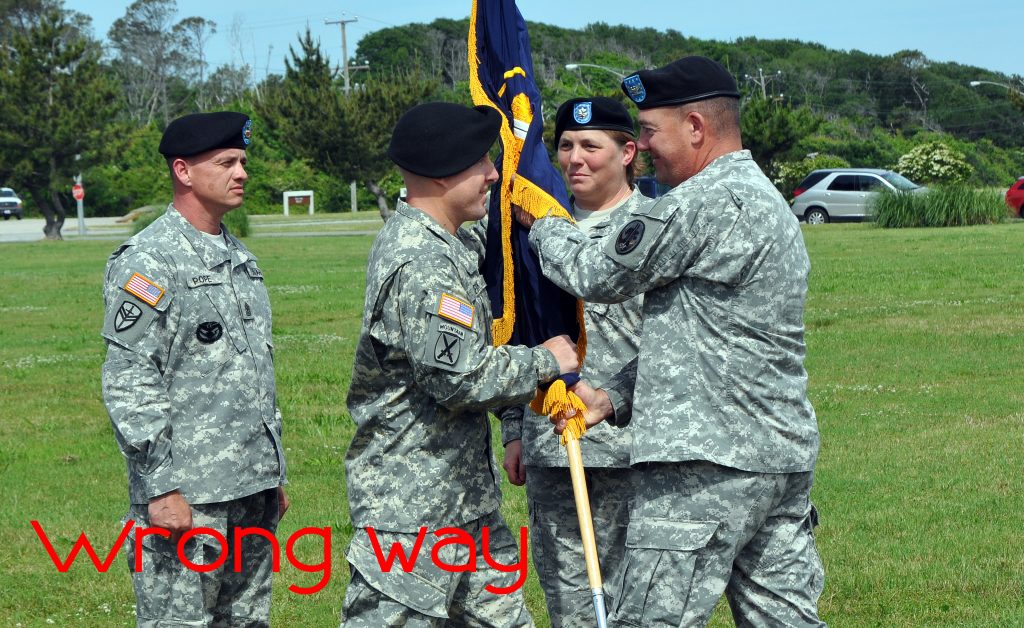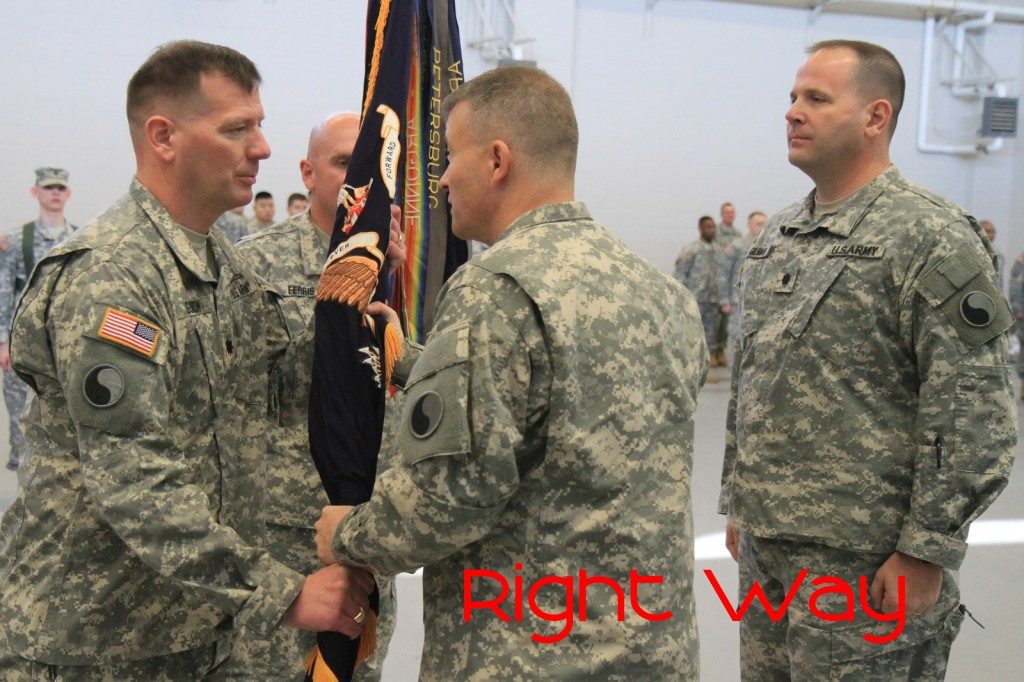There are some ceremonies like the company change of command and the change of responsibility that have some key elements that are not clearly defined, so finding “a standard” is sometimes impossible. In many cases with large formations, it is usually the senior mission command HQs that creates a local policy when it comes to the gray areas surrounding ceremonies but without one you have to wing it. Though in this post I am mainly talking about the actual passing of the colors of a color bearing unit. When it comes to the change of command at the company level you replace the carried colors with the guidon and manual of the guidon remains the same with the guidon bearer filling the role of the battalion level color sergeant.
I don’t really understand why but the confusion caused by the intent to keep the colors/guidon over “the heart” causes much angst and twisting and twirling of the staff that it makes the entire event look messy if those involved don’t understand their role. Hand placement is key and a 1/4 twisting motion of the body at the waist allows a natural motion and will always keep the colors over the incoming and outgoing commanders heart, but not the officiating officer or the senior NCO. The intent is CLEAR in TC 3-21.5, Ch 10-5 about that.
The key is the person initiating the exchange, typically the 1SG/CSM. After the colors are present and the box formation has been formed where the incoming and outgoing commanders are facing each other while the senior official and the senior NCO are facing each other, then the SNCO does an about face and retrieves the flag or guidon. They just reach out and grasp it, there is no presenting or raising by the bearers. The SNCO reaches with their RIGHT HAND up, left hand down on the staff. This is key and important, and if messed up here it will screw everything up. When using organizational colors the SNCO should bunch the cloth of the colors to keep if from dragging on the ground during the exchange.
The SNCO does an about face with the colors/guidon straight up and down and stands that way until the reading of the orders is complete. I do that to keep people from prematurely reaching for the flag. Once the orders are read the SNCO repositions the staff so it is over _their_ right shoulder, like in PORT ARMS or running with the guidon.
The SNCO then takes a natural 30-in step with the right foot and stops, twists their body to the LEFT and hands the colors/guidon to the OUTGOING commander, drops his hands, and then returns to the position of attention. The outgoing commander grasps the top of the colors/guidon with their left hand up (near where the SNCOs right hand is) and the flag/guidon is now properly positioned over the outgoing commander’s heart (reverse port arms).
The OUTGOING commander then twists their body 1/4 turn left and hands the colors/guidon to the senior official, drops his hands, and then returns to the position of attention. The senior official receives the flag with their right hand up and near the outgoing commanders left hand, and now the flag/guidon is over the officiant’s right shoulder.
The INCOMING commander twists their body 1/4 turn RIGHT and receives the colors/guidon from the senior official. The incoming commander grasps the top of the colors/guidon with their left hand where the official’s right hand is and then returns back to their original position. The flag/guidon is now over the incoming commander’s heart (reverse port arms).
The incoming commander presents the colors to the SNCO who retrieves the colors/guidon with their right hand high and places it near the incoming commanders left hand and then returns to the upright position. The colors/guidon are over the SNCOs right should, like port arms. The SNCO turns the colors/guidon so the pole is straight up and down, the officiant (or SNCO) commands CENTER, FACE and all four face the colors, and the SNCO then returns them to the color sergeant/guidon bearer. SNCO or official calls ABOUT FACE, FORWARD, MARCH, and they all walk off the field.
Sure I get it, first world problems. But as standards bearers and “keepers of the colors” it is the role of the noncommissioned officer to uphold the standards and traditions of our organization and education and training is a big part of that. By conducting rehearsals and encouraging those key players to do their part is one way to head these problems off. The more we practice something as natural as passing off the staff in a ceremony like the change of command the sharper the organization looks, because old soldiers in the know can tell what right looks like.
//topsarge
CSM (Ret.) Dan Elder, USA
@dandotelder
“The appearance of U.S. Department of Defense (DoD) visual information does not imply or constitute DoD endorsement.”



I am glad to see this article written… Time and time again I attend changes of command ceremonies and see this exact error made at the BN, BDE, and even Division Level. When I corrected it as a 1SG during multiple COCs I conducted, Officers and Senior NCOs looked at me as if I were crazy. “It has to be over everyones heart”, or ” the spade has to be kept in the center of the square”. It got to the point where I researched regulatory guidance to make sure I wasn’t the one wrong due to a change or update.
Here recently I watched a rehearsal with the same error and was given the above two responses. Its a systemic problem across the board where Its been conducted “wrong for so long, everyone thinks its right”. I took the time to educated the leaders present and hopefully it will be rectified at future events their responsible for. Again a great and educational leader development article.